Welcome to five days of learning using small worlds. Use these ideas with your children to develop a wonderful, in-depth week of imaginative, language-rich play.
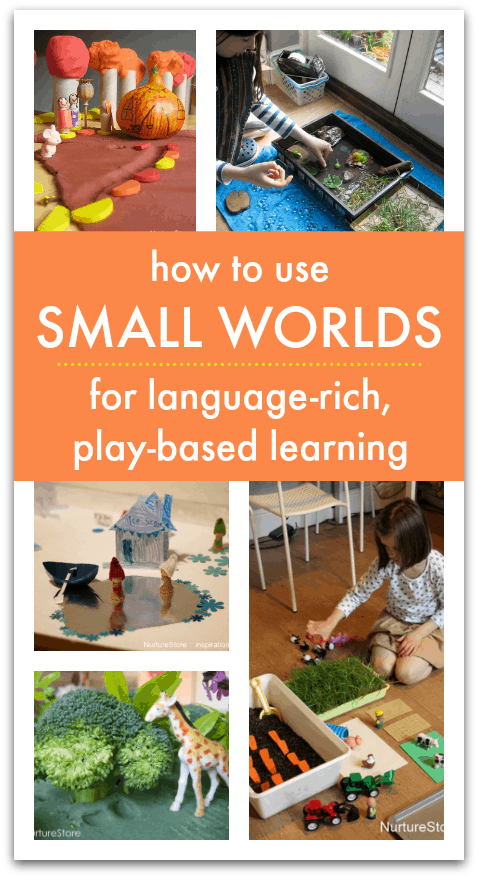
Five days of learning with small worlds unit
NurtureStore hosts regular themed weeks of creative learning activities, giving you ideas, lesson plans, and printables all year round.
This week our focus is on small worlds. A small world is a mini playland which children can create themselves, using characters, props and sensory play materials.
Through small world play your children can:
:: develop language, learn and practise new words, and make conversations between characters
:: explore with their senses and invent things with loose parts
:: try out new situations or work on fears or challenges they are facing in real life
:: be the boss, in charge of their own mini world (which every child would love, right?)
And we get a window into them, their minds and their passions, as we watch them direct the play and share what is important to them right now.
The benefits of teaching through units
You might like to pick just one of these ideas to enjoy or offer all five over the course of your week.
It’s such an advantage to give children time to work on a theme.
A themed-week lets children make connections between one idea and another, one material and another, one experience and another.
With a range of linked activities, children are able to compare and contrast, see how things are the same and what’s different – young scientists and creatives in the making.
Coming back to a theme over consecutive days gives time and space for ideas to brew, and the repetition helps children find depth and meaning.
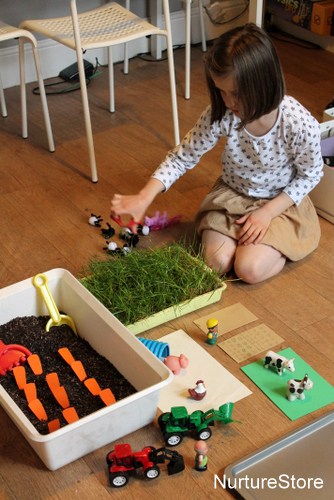
Day One :: introduce your theme
Let’s begin day one of our small world unit by choosing our theme. What kind of small world would your children like to build?
There are many places to take inspiration from:
:: perhaps a big event has happened or is about to happen in your child’s life: a birthday party, a wedding, starting school, going to the beach, getting a new pet
:: you could select a book as your starting point. Choose a new book from the library or read a favourite from your book shelf and use the setting as your starting point
:: a film, TV programme or theatre show can also be an inspiration
:: or perhaps you are already planning a new learning topic and will use that as your theme: oceans, farms, space or castles. Using small worlds alongside another learning unit is an excellent way for children to play with the new concepts they are learning, put new vocabulary into action, and embed their new knowledge through play
So today, read, watch and talk about your chosen theme. Where is the setting for your theme? What does it look like? Who are the main characters? What other things in the world?
Draw or make a few notes to capture the children’s ideas. Write a list of the things you’ll need to get your small world started.
This idea gathering and planning day introduces children to the design process of getting an idea and developing it into a full concept.

Day Two :: make your small world
Let’s make our small world today. Developing from the ideas you talked about yesterday, gather materials to begin creating your small world.
Your small world can be as simple or elaborate as you like. It can use toys, puppets, loose parts and bits and bobs from around the house.
It can be useful to define the area of the small world by creating it on a table, cloth, large piece of paper or designated area of the floor. This gives the small world its own zone, so it doesn’t get damaged and can stay out for several days of in-depth play.
There are no strict rules about how to build your small world but often it starts with a container/area, sensory materials, and a few props such as dolls or puppets.
For inspiration, take a look at our:
:: winter town
:: wedding
:: antarctic
:: farm
:: tea party
:: jungle
:: fairy land
:: frog pond
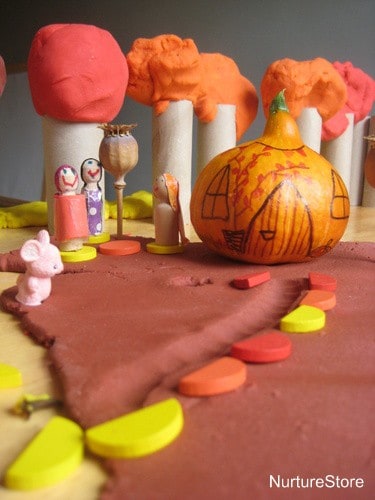
Day Three :: loose parts surprise
Let’s extend our children’s experience of small worlds today by adding in a surprise.
Loose parts are always a wonderful addition to imaginative play. Loose parts are small moveable materials that children can use in their play. They might be bought materials, upcycled from the recycling bin or found natural objects.
By offering your children some extra loose parts today you’re giving their small world play a creative boost. Not only from an artistic point of view – although your children may well make and build in their small world using the loose parts – but the opportunity for creative play that encourages brain development, scientific experimenting, mathematical thought, risk taking, and trial and error learning.
So today, add in a few extra materials for your children to discover when they come to play with their small world. You might add new props, natural materials, pieces of fabric, recyclables. Anything goes, so long as the materials are safe for your children to play with. Also, importantly, you don’t need to have a plan in mind for how the children might use the loose parts – let them decide.
Maybe they’ll add items to their small world, use the materials to extend the land, or even make dress-up costumes for themselves to wear, linked to the small world theme.
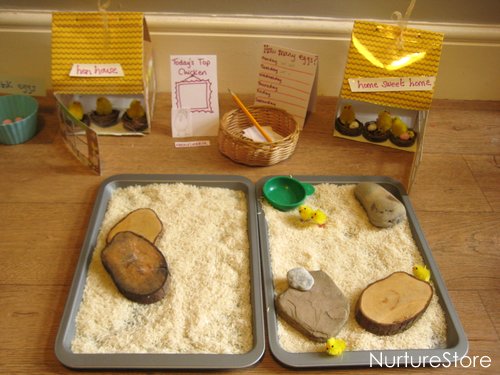
Day Four :: mark making and writing
On day four of our small world unit, let’s add mark making and writing into the mix.
There are many ways to do this, depending on the theme of your small world and the age / stage of your children. Some ideas to try include:
:: setting out colourful and interesting pens, pencils and notepaper alongside the small world – for notes, sketching, or however your children choose to use them
:: adding signs and notices to the small world: labels, sign posts, street signs
:: adding a menu or posters to the small world
:: writing a letter from the characters in the small world to your children, and inviting them to write back
:: adding in alphabet printables to match your theme such as dinosaurs, vehicles, fish or leaves.

Day Five :: junk model additions
Cardboard at the ready! Let’s add junk models to our small world today.
Junk modeling means using craft materials, cardboard boxes, packaging, and items from the recycling box to make things with.
You can make buildings, vehicles, creatures, or anything your imagination can dream up!
Set out a pile of ‘junk’ along with scissors, pens and sticky tape and invite your children to make something to go in their small world or inspired by their small world.
You can find more ideas for junk models here.
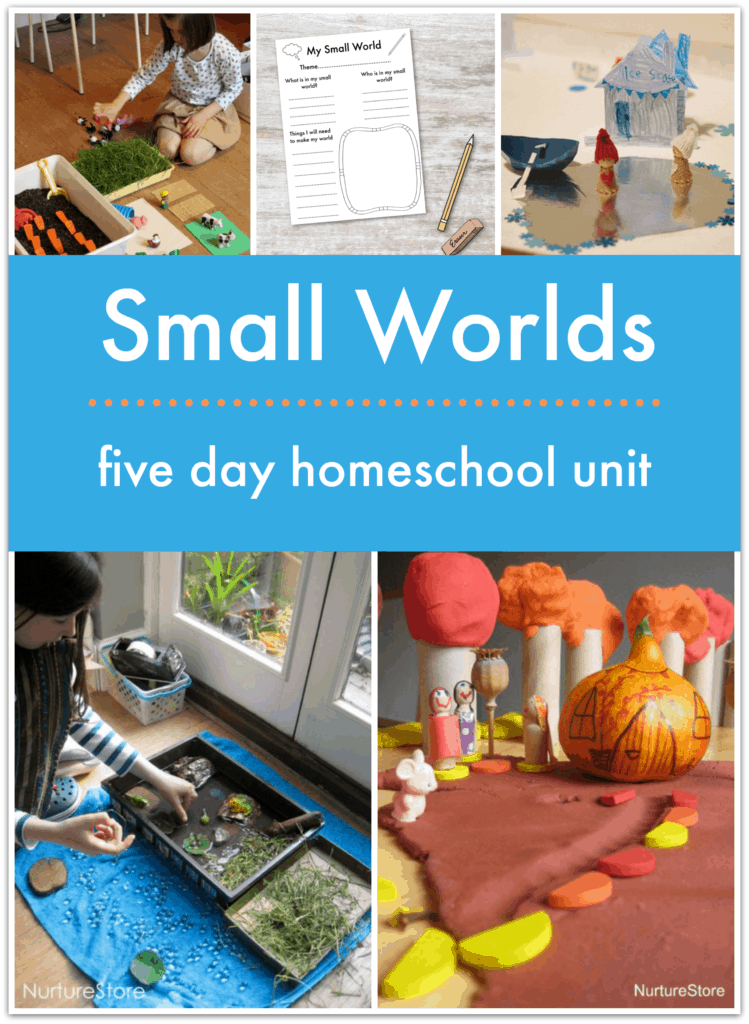
Download this unit and printables
This Small Worlds Unit is available as a pack you can download and print out. You’ll get all the lessons, activities and printable.
Click here to download a copy of this Unit for free (Play Academy members only) – to become a Play Academy member click here.
Alternatively, if you’re not a Play Academy member, you can purchase this unit as a stand alone item here.
Available for instant download
This product is an ebook (electronic book), which means you will be sent a link by email which allows you to download the ebook and all the resources. You should save it to your computer or iPad and then either read it on screen or print some/all of the pages, as you prefer.
Questions?
If you have any questions, then please refer to our FAQ.
Important Information
By purchasing items from our website you consent to our Privacy Policy.
All ebooks and other digital products listed on this page protected under copyright ©. All rights reserved. They may not be shared or distributed in any way or form.
All products listed on this page are priced in US dollars. If you are outside the USA, the amount appearing on your bank/credit card statement will be in your local currency based on the exchange rate applicable at the time of the payment.

